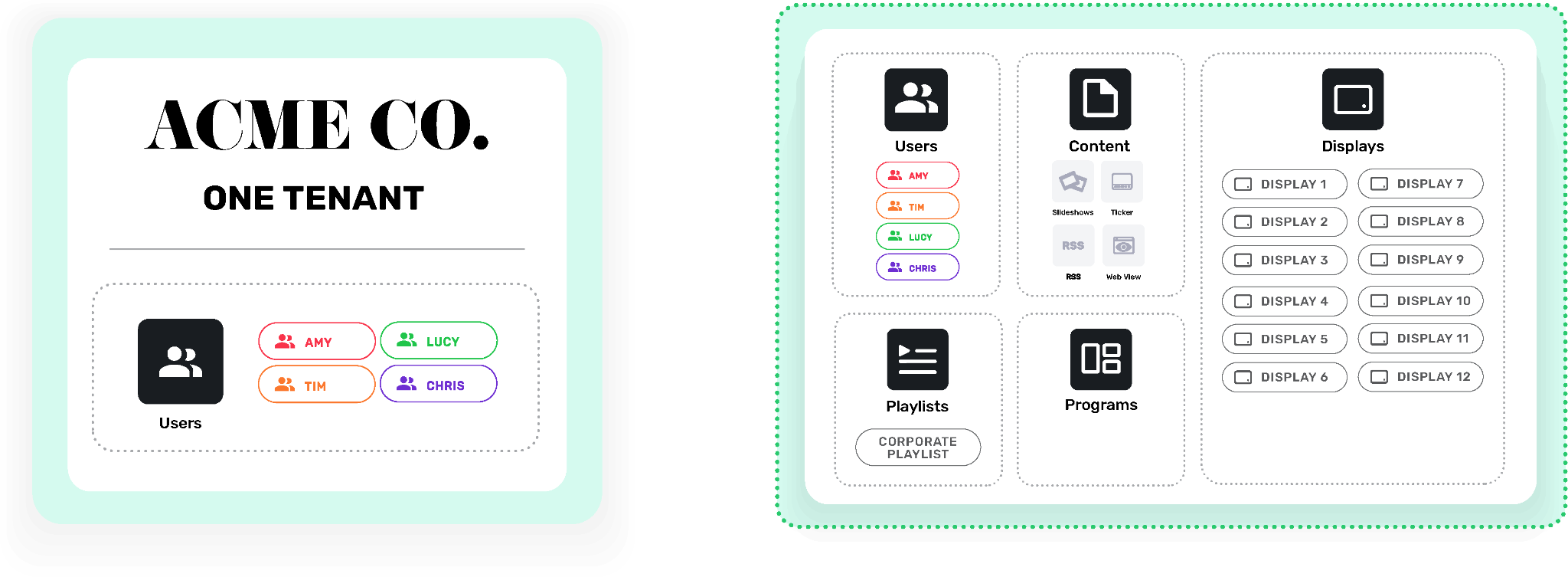Skykit uses a “tenant” structure to help customers organize their content and devices. A tenant is a grouping of devices that provides a way of managing content and access to Skykit products. A company with offices in three different cities, for example, might have three tenants, each one representing an office. Each tenant might have three displays and two content managers who have access to the content and the displays in that tenant.
The following example might help you determine the best way to set up the tenant structure for your company.
When Acme Co. started using Skykit products, they set up a single large tenant that includes 12 displays across four locations. Four employees—Amy, Tim, Lucy, and Chris—have access to the tenant in Skykit Beam and can create and curate content and publish it to any of the 12 displays.

Over time, however, they find that having all 12 displays in a single tenant, with four people who can manage both content and displays, is cumbersome and confusing. So they have Skykit create three additional tenants based on location and organize the displays and content managers accordingly.
Now there are four tenants: Corporate, Los Angeles Facility, Sales Office, and Leasing Facility. Each tenant includes only the displays that are physically at that location. In addition, the four content managers have varying access to the new tenants. Amy, who is in Corporate Communications, needs access to all content and displays, so she has access to all four tenants. Chris has access to the Corporate and Sales Office tenants; and Tim and Lucy have access to the Los Angeles Facility and Leasing Facility, respectively.

This means Amy can publish content to any or all of the 12 displays, whereas Tim can only publish content to the displays in the Los Angeles Facility tenant.
Each content manager is responsible for content specific to their tenants, but Amy also wants them to play a corporate playlist that she maintains in the Corporate tenant. She could create the playlist and send it to the other content managers so they can publish it to their displays, but that isn’t very efficient—when Amy updates the playlist, she’ll need to send it to the other content managers again and make sure they’re all playing the updated content.
With this situation in mind, Acme Co. decides they want to be able to share content across tenants. They contact Skykit to enable content sharing, with the Corporate tenant as the sharing tenant. Amy can now create a playlist in the Corporate tenant and then share it with the other three tenants so it can be published to the displays in those tenants. The other content managers can’t edit the shared content, so Amy has complete control over it. When she edits the shared playlist, the changes are automatically updated in every tenant it’s shared with. The other content managers are still responsible for publishing any new content Amy shares with them, but any updates she makes will play automatically.
Your Customer Success Manager can help you set up your tenant structure so it meets your digital signage needs.